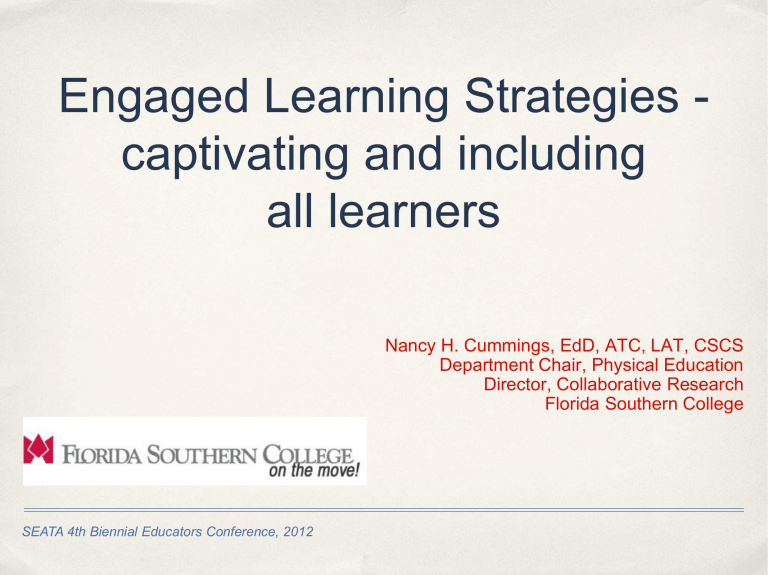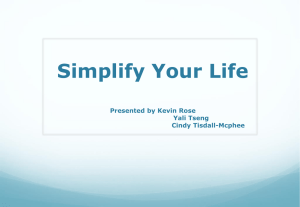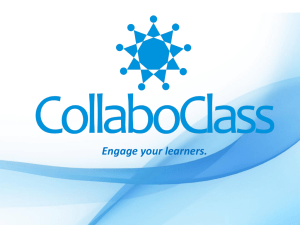Engaged Learning Strategies - captivating and including all learners

Engaged Learning Strategies captivating and including all learners
Nancy H. Cummings, EdD, ATC, LAT, CSCS
Department Chair, Physical Education
Director, Collaborative Research
Florida Southern College
SEATA 4th Biennial Educators Conference, 2012
Agenda
✤
Define engaged learning
✤
Types of learners
✤
Bloom’s Revised Taxonomy and learning strategies
✤
Pair learning strategies/activities with our students
✤
Question & Answer
What is your current path???
What does engaged learning mean to you???
✤
Affinity Diagram...
Engaged Learning
✤
Actively engage students in discovering new knowledge in a sequenced, developmentally appropriate way to enable them to evaluate evidence critically, make informed judgments, and act ethically. (AACU, 2009)
• transitive verb (Miriam Webster’s Dictionary)
✤
✤
1 : to offer (as one's word) as security for a debt or cause
✤
Out of curiosity “to engage” b : to attract and hold by influence or power
✤ c : to interlock with : mesh ; also : to cause (mechanical parts) to mesh < engage the clutch>
✤
3 : to bind (as oneself) to do something; especially : to bind by a pledge to marry
✤
4 a : to provide occupation for : involve < engage him in a new project>
✤ b : to arrange to obtain the use or services of : hire < engage a lawyer>
✤
5 a : to hold the attention of : engross <her work engages her completely> b : to induce to participate < engaged the shy boy in conversation>
Key definitions for us
•
5 a : to hold the attention of : engross <her work engages her completely>
✤ b : to induce to participate < engaged the shy boy in conversation>
•
Students’ intellectual capacities emerge gradually when educators foster their holistic growth through continuous self-reflection, seamless and authentic curricular and cocurricular experiences that steadily increase in challenge, and appropriate levels of support. (AACU,
2009)
The FSC version
✤
“Experiencing the world beyond the classroom is an essential part of your Florida Southern education. As a national leader in engaged learning, we believe education should be not be a spectator sport. With a low student-tofaculty ratio, you will be at the center of your education.”
(FSC, 2012)
✤
“We are nationally recognized for our focus on ‘engaged learning’. Each academic program encourages students to engage in research projects with professors, performances on our stage, exhibitions in our gallery, study abroad, internships and community service. Our learning is hands-on, and you will benefit most from the
FSC experience.” (FSC, 2012)
Why does engaged learning work?
✤
Movement prepares the brain to learn (Madigan, Kovalik, Jensen,
Colcombe & Thompson, Van Praag)
✤
The benefits of 45 seconds of activity can last 15-20 minutes
(Madigan, Ratey)
✤
Employ “7 steps” as often as possible to release BDNF - the SPARK for learning (Ratey, Madigan, Kubota)
✤
Crossing the midline facilitates the brain to organize itself (Dennison,
Ratey)
✤
The brain uses motor patterns as the framework for other learning
(Jensen, Ratey, Madigan)
✤
Memory is best retrieved when learned through movement (Jensen)
✤
The truth…
we learn 10% of what we read
we learn 20% of what we hear
we learn 30% of what we see
we learn 50% of what we hear and see
we learn 70% of what we discuss with others
we learn 80% of what we personally experience
we learn 95% of what we teach others
(Holt & Kysilka, 2004)
✤
Ask yourself the tough question about your classroom settings...
Types of learners - old model
✤
Visual learners -
✤
Kinesthetic learners -
✤
Auditory learners -
✤
Stir the Class...
Types of learners - old model
✤
Visual learners - students learn best by seeing things or watching
✤
Kinesthetic learners - students learn best by doing, moving their bodies, clapping, working with their hands, creating things, and performing
✤
Auditory learners - students learn best by hearing things, using their ears and their voices
Types of learners - new model
✤
Comprehension learners - students draw a quick mental sketch of the material to be grasped, using analogies, metaphors, and ties to personal experience, and then fill in and alter that framework as they acquire more and more detailed information
✤
Operations learners - students build up a framework piece by piece only as they acquire knowledge of the details
(Rhem, 1995)
✤
“Learning styles of undergraduate students become similar to their role models (teachers).” (Shein and Chiou,
2011)
•
Can we combine both models for today’s students?
✤
Visual vs Kinesthetic vs Auditory
✤
Comprehension vs Operations
✤
Are they exclusive???
✤
How are we training are students???
How do we pair instruction to our learners?
✤
Table Web...
Bloom’s Revised Taxonomy
Engaged Learning refresher
✤
Actively engage students in discovering new knowledge in a sequenced, developmentally appropriate way to enable them to evaluate evidence critically, make informed judgments, and act ethically. (AACU, 2009)
What can you do different...
✤
Reflection...
What is your path now?
Question and Answer
Thank you!
✤ ncummings@flsouthern.edu
References
✤
AACU - American Association for Colleges and Universities webpage publications
✤
FSC - Florida Southern College webpage
✤
Holt and Kysilka (2004)
✤
Rhem, J. (1995) Deep/surface approaches to learning: An introduction. The National Teaching and Learning Forum , 5(1), p1.
✤
Schein and Chiou. (2011) Teachers as role models for students’ learning styles. Social Behavior & Personality: An International
Journal , 39(8), p1097.






